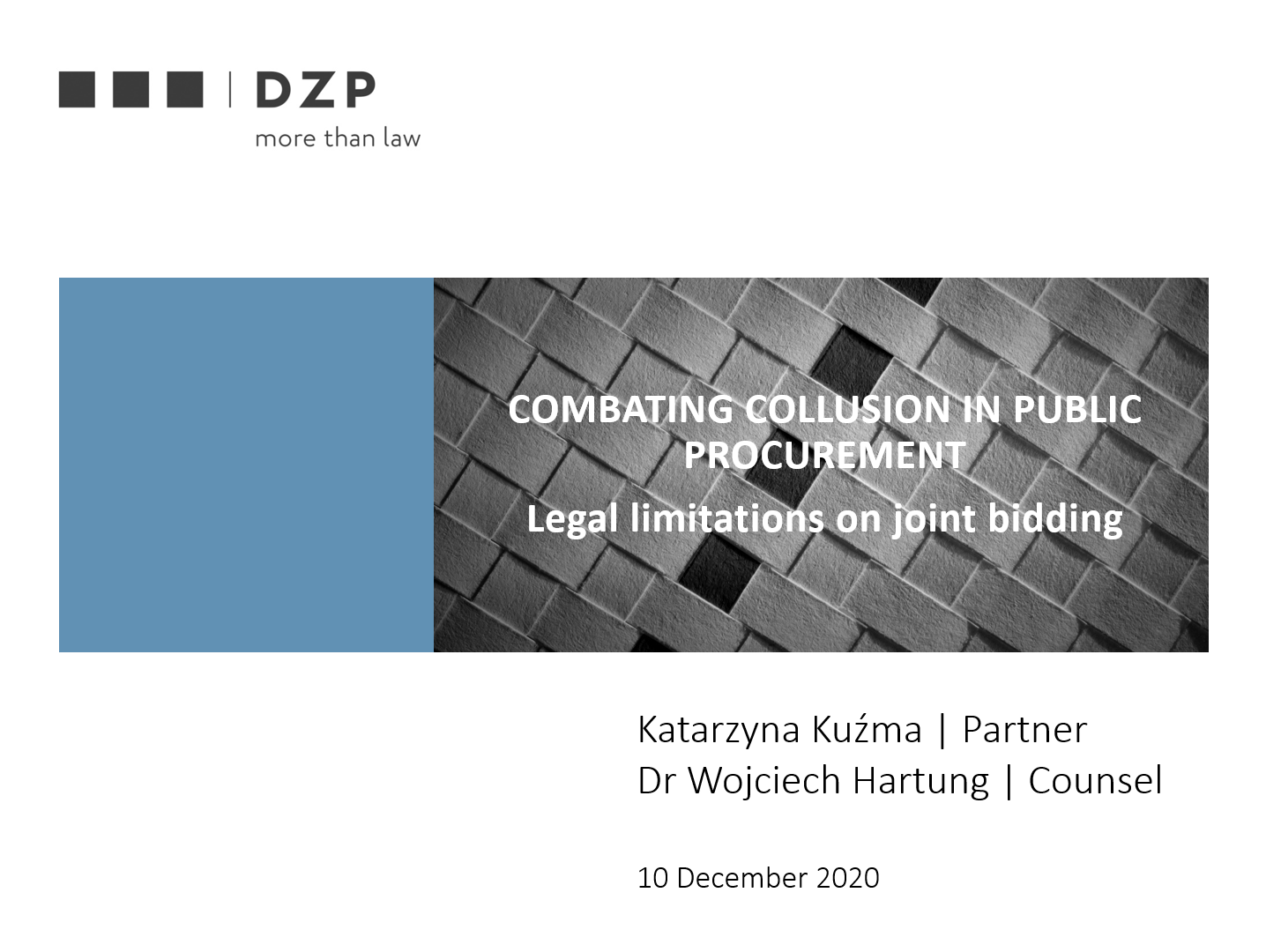On 18 March 2021, the European Commission officially published its Notice on tools to fight collusion in public procurement and on guidance on how to apply the related exclusion ground (the ‘bid rigging exclusion guidance’). This document has been a long time in the making and officially announced almost four years ago, so it is no exaggeration to say that it was keenly awaited (by competition and procurement geeks like yours truly, at least).
The guidance is clearly addressed to contracting authorities — not economic operators — and is distinctly ‘pro exclusion’ in its minimisation of the practical difficulties and legal constraints inherent in the adoption of exclusion decisions. However, even with such clearly programmatic orientation, after a first reading, I have a few thoughts that do not make for an optimistic assessment of the guidance’s likely practical impact.
Mostly, because I do not think the Commission’s bid rigging exclusion guidance provides much by way of actionable practical advice to contracting authorities—and it certainly does not really go beyond already existing guidance, such as the OECD’s 2009 guidelines for fighting bid rigging in public procurement. By contrast with more general documents e.g. the OECD guidance, the Commission’s bid rigging exclusion guidance intends to concentrate on the possibility to exclude operators engaged in the manipulation of a tender. However, it includes lenghty discussion of measures to prevent collusion, as well as complementary measures such as training and data analysis and, when it comes to the specific issues that the interpretation and application of Art 57(4)(d) of Dir 2014/24/EU generates, it is mainly restricted to setting out issues that Member States’ domestic legislation cannot do — rather than focusing on what contracting authorities can (and should) do.
Moreover, its likely limited practical impact results from the fact that the guidance simply ignores that the EU rules (especially discretionary ones) need to be embedded in the Member States’ administrative/public law system and, in many places, the guidance is at odds with the latter. In that regard, the guidance seems to presume a sort of sphere of subjective rights for contracting authorities that they are capable of exercising even against the decisions of other (superior/centralised) administrative authorities, or in disregard of broader constraints and requirements for administrative action—such as burden of proof, the duty to state reasons, the increasing enforceability of exclusion grounds against other tenderers, or the very practical implications of risking damages compensation for unlawful exclusion—which is (as far as I know) an area of constant interest for tenderers and practitioners alike.
To be fair, this in part follows from the stance of the Court of Justice in some recent cases (referred to in the guidance), but that is still no excuse for the Commission’s guidance not to recognise that Member States retain significant discretion in their administrative self-organisation and that some of the issues raised in the practical implementation of the relevant provisions will be conditioned by pre-existing administrative law doctrines and procedures.
The most glaring example of this approach that sidesteps the difficulties in the domestic implementation of EU procurement law is the fact that the guidance simply states that ‘The possibility to exclude an economic operator for suspected collusion is not construed in the Directive as a penalty for its behaviour before or during the award procedure’ (section 5.2). That is at face value fine. But the Directive also does not say that exclusion is not a penalty or a sanction and, consequently, establishing the legal nature of an exclusion will be dependent on the relevant public/administrative law framework at Member State level. Moreover, exclusion has been framed as a penalty in at least one recent preliminary reference and the Court of Justice has not disabused the referring court from that prima facie legal classification (see eg Tim, C-395/18, EU:C:2020:58). Given the increasing relevance of the Charter of Fundamental Rights in the interpretation of economic operators’ rights in the context of procurement litigation, I think it is far from certain that exclusion will not be construed as a (quasi)penalty, in particular when it is grounded on the infringement of prohibitive legal rules (such as Art 101 TFEU), rather than on shortcomings in the standing of the economic operator or non-compliance of its tender with substantive and formal requirements included in the tender documents.
To my mind, this (ie the nature of exclusion measures) can be one of the thorniest interpretive issues in this area, particularly because of the due process implications of exclusion being treated as a penalty or sanction—which is also not helped by the absence in the Remedies Directive of any procedural requirements applicable to the exclusion stage. The perpetuation of this disconnect with the Member States’ administrative law framework can in itself constitute the quicksands where the bid rigging exclusion guidance disappears, and certainly can continue to prevent an adequate use of the possibility to exclude tenderers suspected of bid rigging, because the fundamental issues raised by Art 57(4)(d) Dir 2014/24/EU remain unresolved — coupled with other sweeping statements concerning e.g. the level of demonstrability of the suspected collusion that contracting authorities need to meet (as discussed below).
For these and the reasons given below, I am afraid that the bid rigging exclusion guidance will not leave up to the expectations. I will carry out a more detailed and formal assessment of the guidance in a future research paper (likely after my shared parental leave… so not until mid summer or so), but here are my further initial observations, which do not attempt to be comprehensive.
Framing the issue
For those interested in understanding how to interpret and apply Art 57(4)(d) and the associated Art 57(6) self-cleaning possibilities, only section 5 and the Annex of the bid rigging exclusion guidance will be relevant. Indeed, the bid rigging exclusion guidance includes a rather lengthy explanation of what the Commission has done and what it expects to do (or for Member States to do) in the broader area of professionalisation and promotion of collaboration between competition and procurement authorities, which makes the document not very practical. This raises some questions on the fitness for purpose of the document, and whether alternative guidance format that had discharged most of sections 1 to 4 onto a different policy document would have been preferable, but perhaps this is mostly just presentational.
One of the most welcome aspects of the bid rigging exclusion guidance is that, in section 5.2, it makes it clear that the ground for exclusion based on suspected ‘contemporaneous’ collusion (or bid rigging) in Article 57(4)(d) of Directive 2014/24/EU is separate from (and compatible with) the possibility of excluding infringers of competition law as economic operators ‘guilty of grave professional misconduct’ under Article 57(4)(c). It is also to be welcome that, also in section 5.2, the Commission shares the view that, despite the different wording of Art 57(4)(d) and Art 101 TFEU, the former needs to be interpreted in a Treaty-consistent manner, which means that the exclusion must be possible for all types of behaviours caught by Art 101 TFEU — notably, concerted practices and decisions by associations of undertakings, in addition to agreements [for discussion, and advancing the positions now confirmed by the guidance, see A Sanchez-Graells, Public Procurement and the EU Competition Rules (2nd edn, Hart 2015) 296 ff].
The Commission also rightly stresses that contracting authorities in principle retain discretion not to exclude economic operators suspected of bid rigging, as the exclusion ground in Art 57(4)(d) is discretionary. However, this obviates not only the possibility for Member States to transpose it as a mandatory exclusion ground, but also more general EU law duties (such as the duty not to deprive Art 101 TFEU of its effet utile), and domestic administrative law duties (such as equivalent duties not to promote or tolerate illegal activity, or duties mandating inter-administrative collaboration with competition authorities). In that regard, the bid rigging exclusion guidance could have usefully developed a checklist of reasons that could (objectively) justify not excluding economic operators despite there being sufficiently plausible indications to conclude that the economic operator had entered into agreements with other economic operators aimed at distorting competition. In the end, it will not (or should not) be entirely up to the contracting authority to decide to turn a blind eye on those indicia.
Lack of practical guidance, or guidance that is impractical
Despite the largely correct framing of the issue, and despite acknowledging that tackling bid rigging in procurement is fraught with difficulties, the bid rigging exclusion guidance fails to deliver the much needed practical orientations on how to identify contemporaneous bid rigging and how to apply (as opposed to interpret) the relevant exclusion ground of Art 57(4)(d) Dir 2014/24.
The guidance does not really provide practical tips on how to identify bid rigging in a single tender scenario (which is the most likely to be faced by most contracting authorities). If indications of the existence of bid rigging that require cross-sectional or time series analysis are left to one side (as those are generally not for contracting authorities, but rather for competition authorities to screen for and analyse), and with the exception of flagging as suspicious unexpected tender withdrawals (annex, section 3), the only indications highlighted in the guidance (section 5.3) are:
The text of the tenders (for instance, the same typos or phrases in different tenders or comments left by mistake in the text of the tender indicating collusion among tenderers).
The prices offered in the award procedure (for instance, tenderers who ... offer excessively high or low prices) [although the interaction of this with the rules on abnormally low tenders is not explored]
Administrative details (for instance, tenders submitted by the same business representative)
This is then slightly expanded in the annex (section 3), which details indicia such as:
Identical mistakes or spelling errors in different tenders.
Different tenders drafted with similar handwriting [in 2021!] or typeface [except default in most commonly used software applications, one would hope!].
Tenders using another tenderer’s letterhead or contact details.
Different tenders with identical miscalculations or identical methodologies to estimate the cost of certain items.
Tenders submitted by the same person or with persons having the same contact details.
This can only help contracting authorities identify clumsy economic operators, potentially involved in collusion. However, in all seriousness, this is unlikely to result in much practical results as once these types of issues are included in official guidelines, it is likely that economic operators will make sure to avoid those mistakes when thy submit rigged bids [for discussion, in the context of automated treatment of bids, see A Sanchez-Graells, '"Screening for Cartels" in Public Procurement: Cheating at Solitaire to Sell Fool’s Gold?' (2019) 10(4) Journal of European Competition Law & Practice 199–211].
The guidance also incurs in temporal inconsistencies, such as when it uses as an indication of bid rigging that contracting authorities should take into account for the purposes of exclusion: ‘The selected tenderer subcontracting work to unsuccessful tenderers for the same contract or the selected tenderer not accepting to sign the contract and later found to be a subcontractor of the tenderer that is finally awarded the contract may be considered sufficiently plausible indications of collusion’ (annex). This can well be an indication of bid rigging, but at this stage no exclusion can take place because the contract will have been awarded. Consequently, the relevant consequence here should be reporting this issue to the competition authority as well as, where possible, terminating the contract (which is not, however, explicitly foreseen in the Directive).
The guidance is also somewhat naive or flippant, for example in its remarks concerning the contracting authority’s (potential) knowledge that a tenderer ‘has pre-ordered the material needed to perform the specific contract in question well before the evaluation of the tenders is concluded’. Quite how a contracting authority would get to this knowledge, or how specific the pre-order should be for it not to be susceptible of confusion with just a standard supply of the economic operators is anybody’s guess.
It can also generate confusion when it, on the one hand, recommends resorting to centralised procurement as a way of avoiding collusion and, on the other, stresses that framework agreements managed by central purchasing bodies are more susceptible to collusion than ordinary tender procedures (annex, section 2).
Moreover, the guidance lacks detail in crucial aspects and, in particular, concerning the extremely complex analysis of joint tenders and subcontracting among (potential) competitors (section 5.6). Here, the Commission’s guidance does not even cross-refer to the more detailed guidelines published by some Member States’ competition authorities — notably, the Danish Competition and Consumers Authority. Similarly, the guidance largely brushes over the complex issue of multiple participation by economic operators belonging to the same corporate group (section 5.5), and also sets aside the difficulties of deciding the scope of application of exclusion decisions that need to respect the doctrine of the single economic entity under competition law [for discussion, see K Kuzma and W Hartung, Combating Collusion in Public Procurement (Elgar, 2020)].
Let’s ignore the administrative legal framework
The Commission’s bid rigging exclusion guidance largely ignores the administrative legal framework at Member State level. This is not only in relation to the treatment of exclusion as (not) a penalty, but also in relation to evidentiary requirements and the related duty to provide reasons. In that regard, the literal interpretation of the Directive leading to the conclusion that ‘national rules should comply with both the letter and the spirit of the Directive, which requires only “indications” of participating in illegal agreements that distort competition in an award procedure and not formal evidence, such as a court judgment confirming such participation’ (section 5.4) is misleading and conflates the need for a prior administrative or judicial decision with the existence of ‘evidence’ of collusion.
First, the guidance is right to exclude the need for a previous administrative or judicial decision, but that should not be treated as excluding ‘evidence’ of collusion, but rather as a precedent decision that has the effects of (quasi) res iudicata or, at least, constitutes a legal fact that the contracting authority cannot ignore. It is also wrong to indicate that ‘plausible indications’ of collusion include, for example, ‘information brought to the attention of the contracting authority of an investigation launched by the competition authority or of penal charges brought against the management of the operator for suspected collusion either in the pending award procedure or in other award procedures’, as this raises fundamental issues concerning the presumption of inocence (which treatment will also differ across jurisdictions, depending on e.g. the trigger for the opening of an administrative investigation). Here the guidance makes the reverse mistake of conflating a formal decision with the evidence (presumably) underpinning it.
Second, the guidance ignores the legal meaning of ‘evidence’ when it establishes that ‘contracting authorities are not required to have evidence of collusion in a pending award procedure, as this would contradict the letter of the Directive’. ‘Plausible indicia’ are a type of evidence, falling short of direct (uncontrovertible) evidence, but clearly above the absence of evidence. This should have been clear from the excerpt that the guidance quotes, where the CJEU stressed that ‘anti-competitive behaviour, “may be proved not only by direct evidence, but also through indicia, provided that they are objective and consistent and that the related tenderers are in a position to submit evidence in rebuttal”’ (Specializuotas transportas, C-531/16, EU:C:2018:324, paragraph 37).
Indiciary evidence is still evidence and the unresolved problem is where to draw the line to decide that the contracting authority has enough evidentiary support to adopt an exclusion decision. Moreover, this is of paramount relevance to the adequate discharge of the duty to state reasons. Here, it not only is impossible for a contracting authority to act in the absence of evidence, but the administrative file will usually be accessible to the economic operator for the purposes of its legal defence. This makes the further recommendation for contracting authorities not to disclose to economic operators that they suspect the existence of bid rigging largely impractical, as the contracting authority will only be able to keep this under wraps up to the point where it must make a formal decision and notification to the economic operator affected by the (potential) exclusion.
Some problematic statements
Unfortunately, in addition to the shortcomings stressed above (and some others), the guidance includes some unhelpful statements concerning the interpretation and application of Art 57(7) of Directive 2014/24/EU, in particular when it states that ‘If an economic operator, who has been excluded from award procedures for a certain period under Article 57(7) of the Directive, submits a tender during the period of exclusion, the contracting authority, without any further need for assessment, must automatically reject that tender’ (section 5.9), and when it reiterates that ‘It goes without saying that if the economic operator has been excluded from all award procedures in your country for a period of time and submits a tender during this period, you must exclude it from your award procedure without assessing the tender submitted.’ (section 3 of Annex) (both emphases added).
These statements are, at best, confusing and misleading and, at worse, legally incorrect. In that regard, it should be stressed that Art 57(6) Dir 2014/24/EU is very clear that the conditions for lengthy exclusions stipulated by Member States in the implementation of Art 57(7) are to be applied ‘if no measures as specified in paragraph 6 are taken by the economic operator to demonstrate its reliability’. Therefore, the statements above should have made it clear that further assessment is required and contracting authorities must carry it out where an economic operator, who has been excluded from award procedures for a certain period under Article 57(7) of the Directive, submits a tender during the period of exclusion and it claims to have implemented the sort of measures detailed in Art 57(6).
This is the sort of problematic drafting that should be avoided in official guidance and, in this instance, rectified by the Commission as soon as possible.
Final thoughts
On the whole, a first reading of the guidance does not call for optimism. While the Commission’s bid rigging exclusion guidance does contain some useful information, it is at its weakest in relation to the particularities of the interpretation and application of Art 57(4)(d) and related provisions of Directive 2014/24/EU, which are supposed to constitute its core concentration.
I would not be surprised if contracting authorities found little to no comfort in the guidance when pondering how to address the key issue of how to spot collusion in single-tender settings, how to decide if there are sufficient plausible indications, and how to go about the adoption of an exclusion decision that is, in almost all likelihood, going to be challenged on the basis that it constitutes a sanction/penalty for a (suspected) breach of competition law that the contracting authority has no competence to enforce, or which has not followed the heightened procedural requirements of procedures leading to the imposition of a sanction. It should be obvious that exclusion on these grounds generates the additional risk of a follow-on investigation by the competition authority and/or private litigation, so no economic operator should be expected to just accept an exclusion on grounds of contemporaneous bid rigging under Art 57(4)(d) Dir 2014/24/EU (or, rather, its domestic transposition).
I will continue reflecting on the guidance and its implications, and I am sure there will be a lively debate in the months and years to come. As always, any feedback and comments will be most welcome.






















